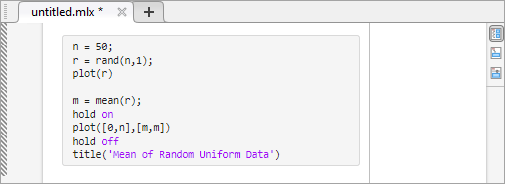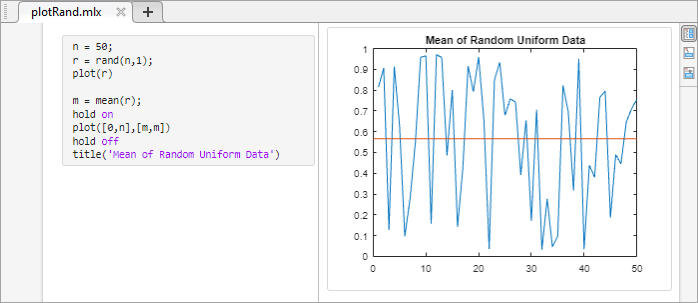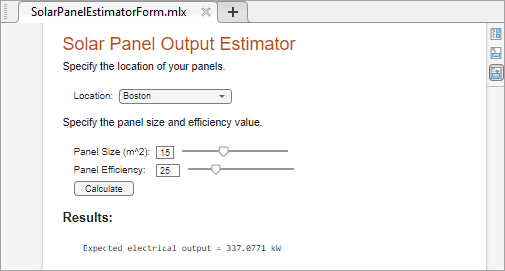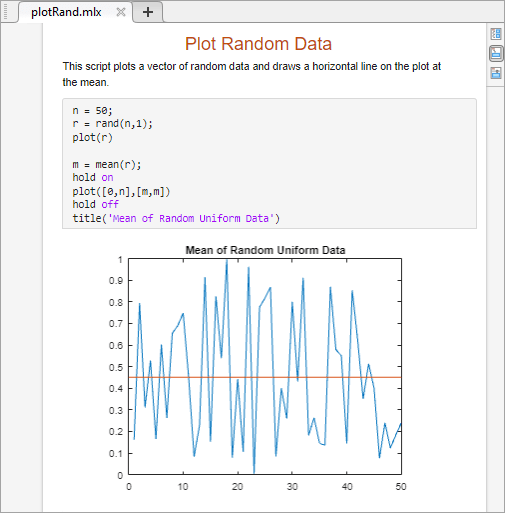在实时编辑器中创建实时脚本
实时脚本是在一个称为实时编辑器的交互式环境中同时包含代码、输出和格式化文本的程序文件。在实时脚本中,您可以编写代码并查看生成的输出和图形以及相应的源代码。添加格式化文本、图像、视频、超链接和方程,以创建可与其他人共享的交互式记叙脚本。
创建实时脚本
要在实时编辑器中创建实时脚本,请转到主页选项卡并点击新建实时脚本 。您也可以在命令行窗口中使用 edit 函数。例如,键入 edit penny.mlx 以打开或创建文件 penny.mlx。为确保创建实时脚本,请指定 .mlx 扩展名。如果未指定扩展名,MATLAB® 默认文件扩展名为 .m,此类型的文件仅支持纯代码。
如果您已有一个脚本 (.m),可以将其作为新实时脚本在实时编辑器中打开。以实时脚本方式打开脚本会创建一个文件副本,并保持原始文件不变。MATLAB 会将原始脚本中的发布标记转换为新实时脚本中的格式化内容。
要通过编辑器将现有脚本以实时脚本方式打开,请右键点击文档选项卡,然后从上下文菜单中选择将 scriptName 以实时脚本方式打开。或者,转至编辑器选项卡并点击保存 > 另存为。然后,将保存类型设置为 MATLAB 实时代码文件(*.mlx) 并点击保存。您必须使用所述的转换方法之一将脚本转换为实时脚本。仅使用 .mlx 扩展名重命名该脚本行不通,并可能损坏文件。
添加代码
创建实时脚本后,您可以添加并运行代码。例如,添加以下代码,以绘制随机数据矢量图,并在绘图中的均值处绘制一条水平线。
n = 50;
r = rand(n,1);
plot(r)
m = mean(r);
hold on
plot([0,n],[m,m])
hold off
title('Mean of Random Uniform Data')

运行代码
要运行代码,请点击代码左侧的斜纹竖条。也可以转到实时编辑器选项卡并点击运行 。当您的程序正在运行时,系统会在编辑器窗口左上方显示一个状态指示符 ![]() 。代码行左侧的灰色闪烁条指示 MATLAB 正在计算的行。要导航至 MATLAB 正在计算的行,请点击状态指示符。
。代码行左侧的灰色闪烁条指示 MATLAB 正在计算的行。要导航至 MATLAB 正在计算的行,请点击状态指示符。
如果在 MATLAB 运行程序时出错,或者 MATLAB 检测到您的代码中存在重大问题,则状态指示符会变为错误图标 。要导航至相应错误,请点击该图标。代码行右侧的错误图标 指示该错误。相应的错误消息显示为输出。
您不需要保存实时脚本即可运行它。
显示输出
默认情况下,实时编辑器在代码右侧显示输出。每个输出都显示创建该输出的代码行。要更改输出显示面板的大小,请向左或向右拖动代码和输出之间的调整大小栏。
当您滚动代码时,实时编辑器会将输出与生成该输出的代码对齐。要在输出位于右侧时禁用输出与代码对齐模式,请右键点击输出部分,并选择禁用同步滚动。

要清除输出,请右键点击输出或创建输出的代码行,并选择清除输出。要清除全部输出,请右键点击脚本中的任意位置,并选择清除全部输出。或者,转到视图选项卡,并在输出部分中,点击清除全部输出按钮。
要在一个单独窗口中打开单个输出,如一个变量或图窗,请点击输出右上角的“在图窗窗口中打开”按钮  。变量将在变量编辑器中打开,而图窗将在新图窗窗口中打开。在实时脚本之外对变量或图窗所做的更改不会应用于实时脚本中显示的输出。
。变量将在变量编辑器中打开,而图窗将在新图窗窗口中打开。在实时脚本之外对变量或图窗所做的更改不会应用于实时脚本中显示的输出。
要修改输出中的图窗,请使用图窗坐标区右上角或图窗工具条中的工具。您可以使用这些工具来探查图窗中的数据,并添加格式设置和注解。有关详细信息,请参阅修改实时脚本中的图窗。
使用键盘与输出交互
通过将焦点从代码移至输出,然后激活输出,您可以使用键盘与实时脚本中的输出进行交互。
当输出在右侧时,要将焦点从代码移至输出,请按 Ctrl+Shift+O 键。在 macOS 系统上,按 Option+Command+O 键。当输出为内嵌时,使用向下箭头键和向上箭头键。当焦点在输出上时,按 Enter 键激活它。激活输出后,您可以使用箭头键滚动文本,使用 Tab 键浏览超链接和按钮,以及通过按 Shift+F10 键打开上下文菜单。要反激活输出,请按 Esc 键。
要在输出为内嵌时禁止使用键盘将焦点移至输出,请在主页选项卡的环境部分中,点击 设置。选择 MATLAB > 编辑器/调试器 > 显示,并清除当输出为内嵌时使用键盘将焦点置于输出选项。
更改视图
通过更改显示输出的位置以及是否在实时脚本中显示代码,您可以为当前工作流优化实时脚本的布局。要更改实时脚本的布局,请转至视图选项卡,在视图部分,从可用选项中进行选择。您还可以选择实时脚本右上角的一个布局按钮。
要在创建新实时脚本时更改输出的默认位置,请在主页选项卡的环境部分中,点击 设置。选择 MATLAB > 编辑器/调试器 > 显示,然后为实时编辑器默认视图选择不同选项。
“右侧输出”视图
在“右侧输出”视图中,实时编辑器在代码右侧显示输出。每个输出都显示创建该输出的代码行。这种布局非常适合编写代码。

“内嵌输出”视图
在“内嵌输出”视图中,实时编辑器使每个输出显示在创建该输出的代码行下方。这种布局非常适合共享。

“隐藏代码”视图
在“隐藏代码”视图中,实时编辑器隐藏代码,只显示输出、带标签的控件、任务和格式化文本。如果实时脚本中的任务配置为仅显示代码而不显示控件,则当您隐藏代码时,该任务不会显示。如果您希望其他人只能更改实时脚本中控件的值,或不希望其他人看到您的代码,此布局非常适合共享。

设置文本格式
您可以将格式化文本、图像、视频、超链接和方程添加到实时脚本中,以创建要与其他人共享的可演示文档。例如,将标题和某些介绍性文本添加到 plotRand.mlx:
将光标放在实时脚本的顶部,然后在实时编辑器选项卡中点击文本 。一个新的文本行将显示在代码上方。
点击“选择样式”按钮
 并选择标题。
并选择标题。添加文本
Plot Random Data。在光标仍置于行中时,点击“居中对齐”按钮 以将文本居中。
按 Enter 键移到下一行。
键入文本
This script plots a vector of random data and draws a horizontal line on the plot at the mean.
有关详细信息(包括所有可用格式设置选项的列表),请参阅在实时编辑器中设置文本格式。

保存实时脚本
要保存实时脚本,请转至实时编辑器选项卡,然后点击保存 。或者,使用 Ctrl+S 键盘快捷方式。输入实时脚本的名称并点击保存。
默认情况下,MATLAB 使用二进制实时代码文件格式 (.mlx) 保存文件。例如,转到实时编辑器选项卡,点击保存 ,然后输入名称 plotRand。MATLAB 会将实时脚本另存为 plotRand.mlx。
要使用纯文本实时代码文件格式 (.m) 保存实时脚本,请在点击保存之前,将保存类型设置为 MATLAB 实时代码文件(UTF-8) (*.m)。有关详细信息,请参阅实时代码文件格式 (.m)。